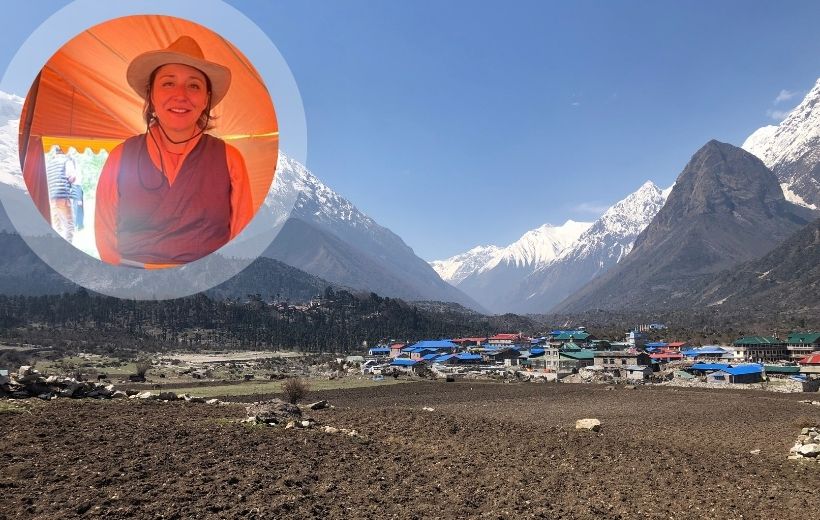Meditation: The Ultimate Comedy Workshop
By Beth Schumann Korczynski • 3 min read
By Beth Schumann Korczynski • 3 min read

Why did the chicken cross the road?
Because when causes and conditions come together, a chicken will cross the road.
As a meditation practitioner and stand-up comedian, I’ve noticed something fascinating: the path to innate well-being has much in common with the path to a good punchline. Who knew?
For over ten years, I made my living by making people laugh — if you can call a few hundred bucks and two drink tickets a living. During this time, I discovered Mingyur Rinpoche’s approach to meditation through Tergar International. At first glance, these two practices seemed as different as a monk and a microphone. However, as my meditation practice deepened, I began seeing surprising parallels.
My impression of a Buddhist monk doing stand-up comedy: So…I’m single. Just kidding. I’m multiple, impermanent, and interdependent.
Take presence, for instance. Stand-up comics call that “being in the room.” Good comedians know that if someone drops a tray of dishes during your set and you ignore it, continuing with your prepared jokes as if nothing happened, you’ve just lost the audience. Why? Because you’re not really there with them. They’re all wondering why you don’t notice that giant elephant in the room. Meanwhile, you’re trapped in your own head, rigidly following a script instead of flowing with what’s happening around you.
Meditation teaches the same lesson. As Mingyur Rinpoche points out in his monthly teaching, he transformed from a serious, worried person into what his students lovingly call a “monkey” — spontaneous, expressive, and real. His hands move freely when he teaches, and he laughs easily. He’s fully present, just as a good comedian must be. If there’s an elephant in the shrine room, I’d count on Rinpoche making it part of the teaching!

Beth Schumann Korczynski working the crowds at the comedy clubs.
How many meditators does it take to change a lightbulb? None — they just observe the darkness with gentle awareness.
Meditation also trains our minds to become more flexible and creative — essential qualities for both spiritual practice and comedy. In Calming the Mind: Joy of Living level 1, Rinpoche teaches that meditation makes our minds more workable and pliable. As we practice, we loosen our grip on rigid thinking patterns and become more open to new perspectives. This mental flexibility enhances our sense of humor. When the mind is supple, we more easily spot those unexpected connections that make things funny. It’s like meditation cleans our mental windshield, letting us see all those amusing patterns and parallels we might have missed before.
I thought I was wrong once, but I was mistaken.
Both meditation and stand-up comedy teach us — sometimes the hard way — not to take ourselves too seriously. As Rinpoche says, everything we experience is “like a TV show or a movie.” In stand-up, if you bomb on stage — comedian-speak for a really bad performance — you can’t let it crush you. You learn what you can and move on. The same goes for meditation, those thoughts that seem so solid and serious — they’re just passing shows in the mind’s theater.
That’s the real magic of combining humor with meditation — it helps us hold our human messiness more gently. Like a diamond covered in mud, our basic nature remains clear and bright, no matter how often we get stuck in old patterns. Learning to laugh at our stumbles while staying committed to growth might be the wisest path of all.
So whether you’re sitting on a meditation cushion or standing on a stage, the key ingredients are surprisingly similar: stay present, keep it real, and don’t forget to laugh. After all, if the path to well-being doesn’t include a few good chuckles along the way, we might be doing it wrong.
January 2025

Prior to joining the Tergar staff, Beth Schumann Korczynski worked as a comedy club manager and professional comedian in the San Francisco Bay Area. During this time, she was introduced to Mingyur Rinpoche’s approach to meditation. Now, as the Director of Philanthropy for Tergar International, she’s traded punchlines for philanthropy but keeps her sense of humor intact. Beth lives with her husband in Ann Arbor, Michigan.
Learn meditation under the skillful guidance of world-renowned teacher Yongey Mingyur Rinpoche at your own pace.


A surgeon shares about the importance of sleep and how we can contend with sleepiness in our meditation.

Discover how a French city-dweller transformed into an environmental pioneer, cultivating 20,000 trees at 3,550 meters in the Himalayas while empowering an isolated Nepali village.

If you have more than one person in a room, you’ve automatically got more than one set of opinions and ideas there, too. And, generally speaking, you’re in a room full of folks secretly thinking that their ideas are best of the lot.
If you enjoyed reading our articles, please join our mailing list and we’ll send you our news and latest pieces.